

Class Diagram Relationships in UML with ExamplesCreately Blog. Many people consider class diagrams a bit more complicated to build compared with ER diagrams.
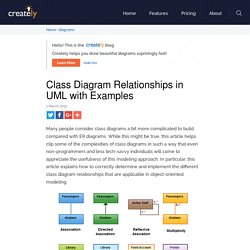
While this might be true, this article helps clip some of the complexities of class diagrams in such a way that even non-programmers and less tech-savvy individuals will come to appreciate the usefulness of this modeling approach. In particular, this article explains how to correctly determine and implement the different class diagram relationships that are applicable in object-oriented modeling. Explicit cookie consent. New sorts of transistors can eke out a few more iterations of Moore’s law, but they will get increasingly expensive THANKS to the exponential power of Moore’s law, the electronic components that run modern computers vastly outnumber all the leaves on the Earth’s trees.

Computer Programming: From Machine Language to Artificial Intelligence. Takeaway: As computing power has increased, programming languages have evolved to take advantage of enhanced computing resources.

Programming languages were used even before computers were invented. Natural language processing. Challenges in natural language processing frequently involve speech recognition, natural language understanding, and natural language generation.
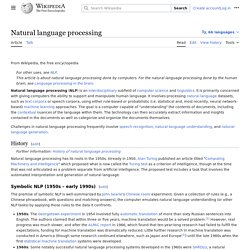
History[edit] The history of natural language processing generally started in the 1950s, although work can be found from earlier periods. The Mind Project: Curriculum. AI, Robotics & Computational Models This module provides an introduction to artificial neural nets with a working network that can solve X-OR problem.

Chain codes are a kind of computer program that can be used to represent the shape of objects. Seven hands-on activities show how to write simple chain codes and explain their application to computer vision. Natural language processing. Gold Mine or Blind Alley? Functional Programming for Big Data & Machine Learning. Functional programming is touted as a solution for big data problems.

PhysicsGirl.com. The Mind Project: Curriculum. The XOR Problem and Solution - The Mind Project. An architectural Solution to the XOR Problem Now here's a problem.
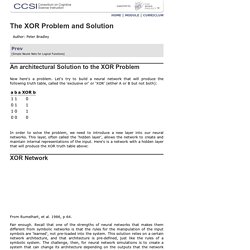
Let's try to build a neural network that will produce the following truth table, called the 'exclusive or' or 'XOR' (either A or B but not both): In order to solve the problem, we need to introduce a new layer into our neural networks. This layer, often called the 'hidden layer', allows the network to create and maintain internal representations of the input. Here's is a network with a hidden layer that will produce the XOR truth table above: XOR Network.
Neural networks and deep learning. One of the most striking facts about neural networks is that they can compute any function at all.
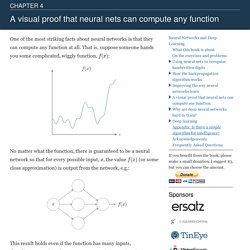
That is, suppose someone hands you some complicated, wiggly function, f(x): Neuroplasticity. Neuroplasticity, also known as brain plasticity, neuroelasticity, or neural plasticity, is the ability of the brain to change continuously throughout an individual's life, e.g., brain activity associated with a given function can be transferred to a different location, the proportion of grey matter can change, and synapses may strengthen or weaken over time.
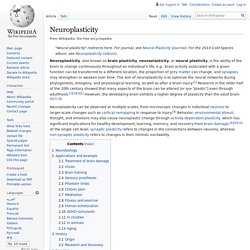
The aim of neuroplasticity is to optimize the neural networks during phylogenesis, ontogeny, and physiological learning, as well as after a brain injury.[1] Research in the latter half of the 20th century showed that many aspects of the brain can be altered (or are "plastic") even through adulthood.[2][3][4][5] However, the developing brain exhibits a higher degree of plasticity than the adult brain.[6][7]:30 Neurobiology[edit] Marvin Minsky's Home Page. MIT Media Lab and MIT AI Lab Professor of Media Arts and Sciences, MIT Professor of E.E.C.S., M.I.Tminsky at media.mit.edu.

Psychology. Psychology is an academic and applied discipline that involves the scientific study of mental functions and behaviors.[1][2] Psychology has the immediate goal of understanding individuals and groups by both establishing general principles and researching specific cases,[3][4] and by many accounts it ultimately aims to benefit society.[5][6] In this field, a professional practitioner or researcher is called a psychologist and can be classified as a social, behavioral, or cognitive scientist. Psychologists attempt to understand the role of mental functions in individual and social behavior, while also exploring the physiological and biological processes that underlie cognitive functions and behaviors. While psychological knowledge is often applied to the assessment and treatment of mental health problems, it is also directed towards understanding and solving problems in many different spheres of human activity.
Etymology History Structuralism. Human echolocation. Human echolocation is the ability of humans to detect objects in their environment by sensing echoes from those objects, by actively creating sounds – for example, by tapping their canes, lightly stomping their foot, snapping their fingers, or making clicking noises with their mouths – people trained to orient by echolocation can interpret the sound waves reflected by nearby objects, accurately identifying their location and size. Google Brain. Google Brain is a deep learning research project at Google. History[edit] In June 2012, the New York Times reported that a cluster of 16,000 computers dedicated to mimicking some aspects of human brain activity had successfully trained itself to recognize a cat based on 10 million digital images taken from YouTube videos.[1] The story was also covered by National Public Radio[2] and SmartPlanet.[3]
Meet the man building an AI that mimics our neocortex – and could kill off neural networks. The Man Behind the Google Brain: Andrew Ng and the Quest for the New AI.